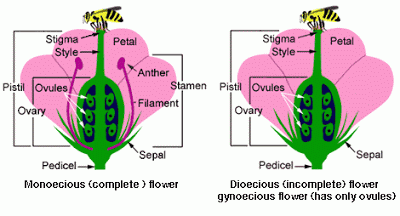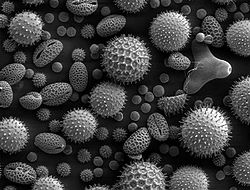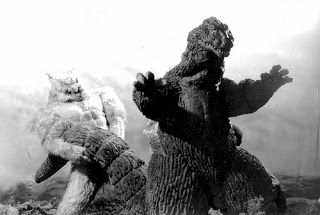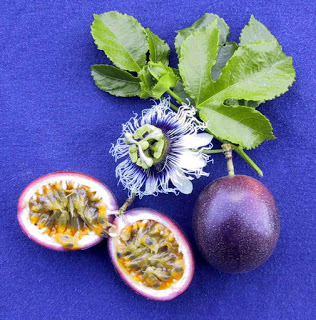Biology
Biology Concepts ? pollen, plastid inheritance, gymnosperms, angiosperms
Yes, thereare female plants. In the plant world, species can be monoecious (mono = one, and ecious = household) or dioecious (di = two). Monoecious plants have individuals that produce both male microgametophytes (pollen) and female megagametophytes (oocyctes or ovules). The individual dioecious plants are either androecious (pollen producing) or gynoecious (seed producing). It's okay to ask if a plant is female, but you still shouldn?t ask her age.
Angiosperms have a maternal inheritance of chloroplast DNA (cpDNA), much like animals have maternal inheritance of mitochondrial DNA (mtDNA). The reasons for maternal inheritance of cpDNA elude me. For mitochondria, the theory is that damage to the sperm mitochondria would occur during the swim to the oocyte, so it would be smart to ban them from the egg.
The pollengrain contains a few different kinds of cells. There are one or more generative cells; these are the reproductive cells of the pollen. There will also be many non-vegetative cells as well. The generative cell has two nuclei. One will divide to become the two sperm cells, while the other will form the tube cell to deliver the sperms cells to the ovule.
Consider this, we now know that the Japanese pronunciation for the big green movie monster is ?go-zeer-a? or ?go-jeer-a,? as it was a portmanteau of the Japanese words for gorilla and whale. But when it came to America, it was just assumed that the name was mispronounced in English and that it was supposed to be ?god-zill-a.? We know it is wrong, but the wrong name still survives; it's what you get used to that sticks around.
In plants, this also holds, and may even be more discrepant. Take the passion flowers (family Passiflora) for instance. Intraspecific breeding (same species) showed the maternal cpDNA inheritance one might expect. But in interspecific crosses the inheritance was 100% paternal. This must represent some attempt to limit the genetic diversity of the organellar genomes, but I leave it to you to explain the reason for it.
The interesting cases are those like the gymnosperms; paternal cpDNA, but maternal mtDNA. Once again, the plants are much more complex and intricate in their behaviors than animals, as two separate mechanisms for organellar retention and degradation must be at work in these plants. But even here there can be exceptions. The coast redwood (Sequoia sempervirens) has normal gymnosperm (paternal) inheritance of cpDNA, but it also has paternal inheritance of mtDNA! And the Chinese fir, which breaks the rules and is a gymnosperm with maternal inheritance of cpDNA, also makes itself exceptional in that it has paternal inheritance of mtDNA! Very confusing.
- Plant Divisions
4 Plant Divisions: Bryophytes are the most common plant division and are made up mosses, liverworts and hornworts. They are found in almost every habitat, including deserts but are most adaptable to moist environments. This is thought to be the first...
- Angiosperm
Term: angiospermLiterally meaning: ?sperm vessel?Origin: Anc Greek??????/aggio (=vessel, receptacle) > ?????/aggos(=tube)?????? (=seed) > ??????/spearo (=disperse)Coined/HistoryAngiosperms appeared during Jurassic period (203-135 million...
- Plus One, Plus Two Biology Question Bank (chapter-wise)
Biology Question Bank (Chapter-wise)PLUS ONE BOTANYBiological classificationPlant kingdomMorphology in flowering plantsAnatomy in flowering plantsCell structure and functionsCell cycle and cell divisionTransport in plantsMineral nutritionPhotosynthesisRespiration...
- Biology Powerpoint Presentations
Biology Presentations for plus one Part-1 Botany Biological classificationPlant kingdomMorphology in flowering plantsAnatomy in flowering plantsCell structure and functionsCell cycle and cell divisionTransport in plantsMineral nutritionPhotosynthesisRespiration...
- Every Day Should Be Mother?s Day
Biology concepts ? inheritance patterns, mitochondria, fertilization, lineage, mitochondrial Eve What do the ?The Battle Hymn of the Republic?, Mother?s Day, and all your mitochondria all have in common? Julia Ward Howe wrote the words for The Battle...
Biology
The Seeds of Inheritance
Biology Concepts ? pollen, plastid inheritance, gymnosperms, angiosperms
I am coming to believe that plants are more complex than animals, even more complex than females. Female plants must be the most difficult things on Earth to understand!
 |
Complete flowers have both anthers for pollen and pistils for egg fertilization. Incomplete flowers occur on dioecious plants, and have either the pistil (gynoecious) or the anther (androecious). Dioecious plants cannot self pollinate, unless they have both types of incomplete flowers, like coast redwoods (see last picture). |
This isn?t even the tip of the tip of the iceberg when it comes to diversity in plant reproduction. There are also different ways to produce seeds. The gymnosperms have unenclosed seeds (gymno = naked, and sperm = seed). Gymnosperms include the conifers (cone producers), the cycads that we talked a little about a few weeks ago, and the gnetum plants. Gnetum plants live close to the equator around the globe and include the Ephedraspecies. It is from these plants that we get ephedrine and pseudoephedrine that work to relieve allergy and cold congestion.
The other type of seed plants is the angiosperms(angio = hidden). These are the flowering plants that have seeds encased in fruits or other structures that help to protect them and to encourage their dispersal.
One way that the gymnosperms and angiosperms differ is in how they inherit their plastid organelles. But even here there is a lot of overlap and exceptions; plants just keep getting more complex.
 |
Gymnosperms have there seeds exposed on the scales of the cones, while angiosperms have the protected inside the fruit (except for strawberries). |
But cpDNA is much more passive, they do not have to do a huge amount of work to get to the ovule of the pollinated plant. The pollen tube grows down to the ovule and delivers the sperm cells right to the egg. There must be some other reason, but I don?t know what it might be.
However, there seem to be more exceptions in angiosperm inheritance of cpDNA than there is in animal mtDNA. A few families of plants, like alfalfa (Medicago sativa) and kiwi fruit vine (Actinidia deliciosa), have a strict paternal inheritance of cpDNA. This is odd since, the angiosperms have a couple of mechanisms for keeping the plastids out of the male gametes.
 |
Every plant species has a distinct pollen shape, which is why you can be allergic to some plants and not others. But each pollen grain has the vegetative cell that becomes the sperms cells and the tube cell. The tube usually grows from the side that rests on the fertilized stigma. |
In many species, when the generative nucleus divides to form sperm, the plastids are partitioned off, and are not included in the sperm cells. This works to ensure maternal inheritance. In other species, the sperm cells may include plastids, but these quickly degenerate and are not delivered to the ovule. Somehow, the alfalfa plants have overcome these mechanisms and even invented a new one to eliminate or exclude the plastids from the ovule, giving strict paternal inheritance.
Going beyond the alfalfa and kiwi fruit ability to preserve their paternal plastids is the fact that a full 20% of angiosperms can show (but don?t have to show), bipaternal inheritance of cpDNA. This is called potential bipaternal plastid inheritance (PBPI) and is controlled by a male gametic trait, called of all things - PBPI trait! Therefore, the fairly strict maternal inheritance of mtDNA in animals (blue mussels excepted) is not matched by cpDNA in angiosperms.
But it gets weirder. The angiosperm exception is normal for the gymnosperm. Gymnosperms tend to have paternal inheritance patterns for cpDNA. This difference is important to note, since scientists often try to use cpDNA inheritance patterns to track seed movements around the world and through evolutionary time, just like human populations are often tracked using mitochondrial ancestry and inheritance.
But this must be frustrating, because there are also exceptions in the paternal inheritance pattern in gymosperms. The Chinese fir (Cunninghamia lanceolata), which isn?t a fir, is native to Asia but was brought to America in the 1800?s. Remember that before molecular biology, most taxonomic classifications were made on just the morphology (shape and look) of an organism, and its grouping and name were based on how it compared to other organisms. Names often get stuck in the language and are hard to change, so many of the misnomers persist.
 |
Godzilla, or Gojira, always seemed surprised when the other monster grabbed his tail. Here it happens to be a giant wolfman. Everybody cashed in on the werewolf brand; I am surprised Abbott and Costello aren?t in that picture somewhere. |
But back to the Chinese fir. This gymnosperm is a conifer that can grown 150 feet tall, but flaunts its individuality by having a maternal inheritance pattern for cpDNA ? much more angiosperm-like behavior than gymnosperm. And this is even odder because the Chinese fir is an older gymnosperm, a much more distant relative to the angiosperms than many gymnosperms that have a strict paternal cpDNA inheritance.
Gymnosperms that show maternal cpDNA inheritance are rare, or just less studied, so one might assume that paternal cpDNA inheritance is fairly strict ? wrong. Many gymnosperms have bipaternal inheritance patterns of plastids, so the mechanism might be different from angiosperms, but is no more consistent than that of the flowering plants.
Finally, there is the issue of crossbreeding. In this animal mtDNA and plant cpDNA seem to be similar. Whatever the dominant form of inheritance is seen in natural breedings, the numbers get screwed up when cross breeding occurs. We saw that paternal inheritance of mtDNA in mice was much likely in the mating of different species (interspecific breeding).
 |
The passionflower vine can grow to be 10 meters high and is the source of the passion fruit that I enjoy so much. The fruit protects the fertilized seeds that probably have paternal cpDNA, since most of the varieties we eat are hybrids of different species. |
The similarity between mitochondrial and plastid inheritance in hybrids brings up another issue ? what about mitochondrial inheritance patterns in plants?
It turns out that most plants that have been studied for mtDNA inheritance have a maternal inheritance pattern, just like animals. Amazingly, this includes the gymnosperms, most of which have paternal inheritance of cpDNA. But even some plants with maternal cpDNA patterns can pass on paternal mitochondria. An example of this is the banana - tomorrow morning you can feel like a rebel for garnishing your cornflakes with such an outlaw fruit.
However, the reason would be different. Remember that sperm have their mitochondria in their tails, and in most animals, this is not included in what enters the egg or is degraded just after entering. But few plants have flagellar sperm (like the cycads we talked about before). The sperm mtDNA is not exposed to anymore oxygen radical damage than the ovule mtDNA, yet there is most often uniparental, maternal inheritance.
Coastal redwoods can reach up to 110 meters (360 ft) tall, but their roots may only go 6 ft. underground. What's holding this tree in place? It has two different types of leaves, and has male and female branches and flowers, but all its mitochondria and chloroplasts come from one place, its father. |
So mitochondria and chloroplasts both work in energy production, both evolved through endosymbiosis, both have single, circular chromosomes (with exceptions), and both have uniparental inheritance patterns (with exceptions). Next week, let?s look a behavior that is different in these two organelles.
For more information or classroom activities on monoecious/dioecious plants, angiosperms, gymnosperms, or plastid inheritance, see:
Monoecious/dioecious ?
http://www.saylorplants.com/SaylorPlants/Ref_Info/Dioecious2w.htm
http://www.google.com/url?sa=t&rct=j&q=&esrc=s&source=web&cd=1&ved=0CEkQFjAA&url=http%3A%2F%2Foklahoma4h.okstate.edu%2Flitol%2Ffile%2Fothers%2Fenrichment%2F4h500.pdf&ei=aXvKT4TuMIeC2wW1q4HaCw&usg=AFQjCNGyz1D_o5uVX0nMrNa2VpjchuJHgw
http://botany.csdl.tamu.edu/FLORA/Wilson/pp/s99/flowers.htm
http://www.oakleafgardening.com/glossary-terms/hermaphrodite-monoecious-dioecious/
http://www.bushmansfriend.co.nz/dioecious-plants-xidc18308.html
Angiosperms ?
http://www.ehow.com/info_8462298_classroom-activities-angiosperms.html
http://www.google.com/url?sa=t&rct=j&q=&esrc=s&source=web&cd=9&ved=0CHIQFjAI&url=http%3A%2F%2Fwww.burpeehomegardens.com%2Fpdf%2FBHC10538-BurpeeICanGrow-PlantClassification.pdf&ei=vn3KT5-dNMnW2gXOjc3ZCw&usg=AFQjCNH5IaI0aDUM1qd4wj_tVEaF-o8-jw
http://alex.state.al.us/lesson_view.php?id=24127
http://www.teachervision.fen.com/seeds/printable/28684.html
http://beckyboop.wordpress.com/2011/04/05/flowering-plants-lesson-plan/
https://www.google.com/#hl=en&sclient=psy-ab&q=gymnosperms+and+angiosperms&oq=gymnosperm&aq=1&aqi=g4&aql=&gs_l=serp.1.1.0l4.50243.54373.3.55834.20.16.1.1.1.13.328.3452.0j9j6j1.16.0...0.0.2xyYaWj6zCc&pbx=1&bav=on.2,or.r_gc.r_pw.r_qf.,cf.osb&fp=9d6464494833eb73&biw=1689&bih=895
Gymnosperms ?
www.clt.astate.edu/mhuss/Lab%20Exercise%2011.doc
http://faculty.unlv.edu/landau/gymnosperms.htm
http://www.gardenbuildingsdirect.co.uk/Article/gymnosperms
http://alex.state.al.us/lesson_view.php?id=24115
http://sfr.psu.edu/youth/sftrc/lesson-plans/forestry/6-8/gymnosperms
http://academic.kellogg.edu/herbrandsonc/bio111/gymnosperms.htm
http://faculty.clintoncc.suny.edu/faculty/michael.gregory/files/bio%20102/bio%20102%20lectures/seed%20plants/seed%20plants.htm
http://www.msnucleus.org/membership/html/k-6/lc/plants/5/lcp5_5a.html
Plastid inheritance -
http://www.ncbi.nlm.nih.gov/pubmed/20052516
http://www.amjbot.org/content/94/1/42.full
http://www.generationcp.org/plantbreeding/index.php?id=015
http://www.clivias.com/Articles/Article016.htm
- Plant Divisions
4 Plant Divisions: Bryophytes are the most common plant division and are made up mosses, liverworts and hornworts. They are found in almost every habitat, including deserts but are most adaptable to moist environments. This is thought to be the first...
- Angiosperm
Term: angiospermLiterally meaning: ?sperm vessel?Origin: Anc Greek??????/aggio (=vessel, receptacle) > ?????/aggos(=tube)?????? (=seed) > ??????/spearo (=disperse)Coined/HistoryAngiosperms appeared during Jurassic period (203-135 million...
- Plus One, Plus Two Biology Question Bank (chapter-wise)
Biology Question Bank (Chapter-wise)PLUS ONE BOTANYBiological classificationPlant kingdomMorphology in flowering plantsAnatomy in flowering plantsCell structure and functionsCell cycle and cell divisionTransport in plantsMineral nutritionPhotosynthesisRespiration...
- Biology Powerpoint Presentations
Biology Presentations for plus one Part-1 Botany Biological classificationPlant kingdomMorphology in flowering plantsAnatomy in flowering plantsCell structure and functionsCell cycle and cell divisionTransport in plantsMineral nutritionPhotosynthesisRespiration...
- Every Day Should Be Mother?s Day
Biology concepts ? inheritance patterns, mitochondria, fertilization, lineage, mitochondrial Eve What do the ?The Battle Hymn of the Republic?, Mother?s Day, and all your mitochondria all have in common? Julia Ward Howe wrote the words for The Battle...
